
Click the name of a planet to learn more about its visibility in April 2021: Jupiter, Saturn, Mars, Venus, Mercury
Try Stellarium for a precise view of the planets from your location.
Want precise planet rise and set times? Click here for recommended almanacs
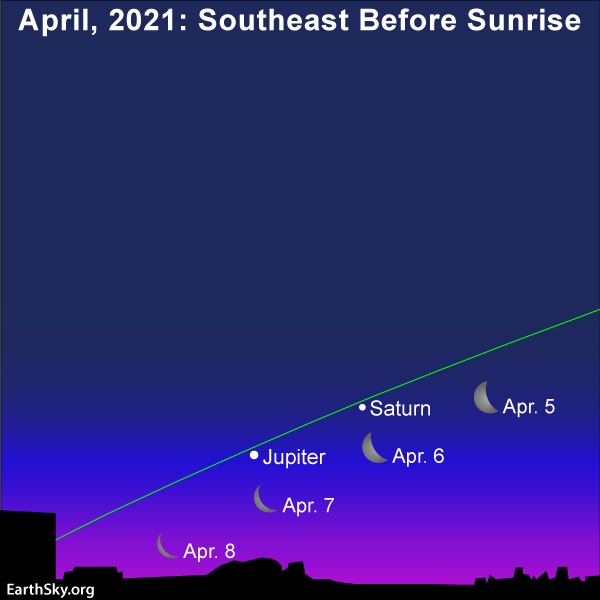
If you haven’t seen Jupiter and Saturn in the morning sky yet, try using the moon to hop over these worlds in the predawn/dawn hours on April 5, 6, 7 and 8, 2021. Read more.

The young moon sweeps to the north of Aldebaran on or near April 15, and then meets up with Mars for an occultation on the night of April 17 (in southeast Asia). Read more.
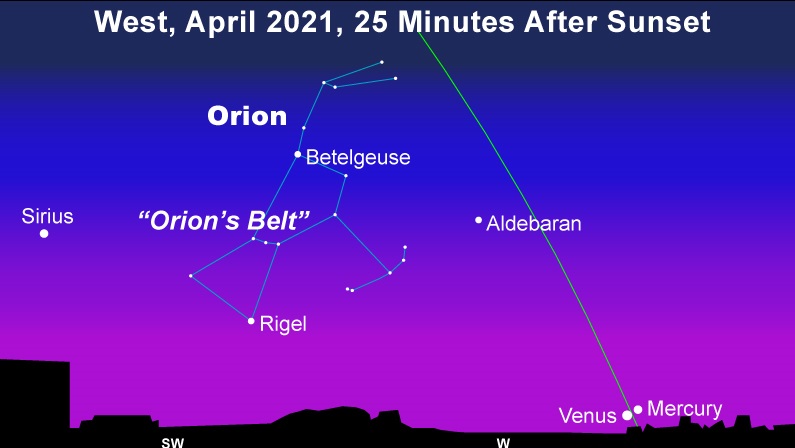
The two inferior planets Mercury and Venus will be difficult to view in April 2021. We expect few – if any – to spot their close pairing on the sky’s dome at dusk April 24, 25 and 26, 2021. Read more.
Mars is the only bright planet to light up the evening sky throughout April 2021 (Jupiter and Saturn are found in the predawn/dawn sky all month long, while Venus sits too close to the sunset glare to be easily seen). Best to seek out this modestly-bright world at early evening, when it’s still relatively high in the sky. Mars slowly descends westward during the evening hours, finally setting in the west at or around midnight at mid-northern latitudes, and by mid-evening at temperate latitudes in the Southern Hemisphere.
Mars starts the month in front of the constellation Taurus the Bull and then passes into the constellation Gemini the Twins on April 24, 2021. Enjoy Mars in April 2021! It’s only going to get fainter as this year progresses. In the months ahead, Mars will slowly but surely dim as – day by day – it will sink closer and closer to the setting sun.
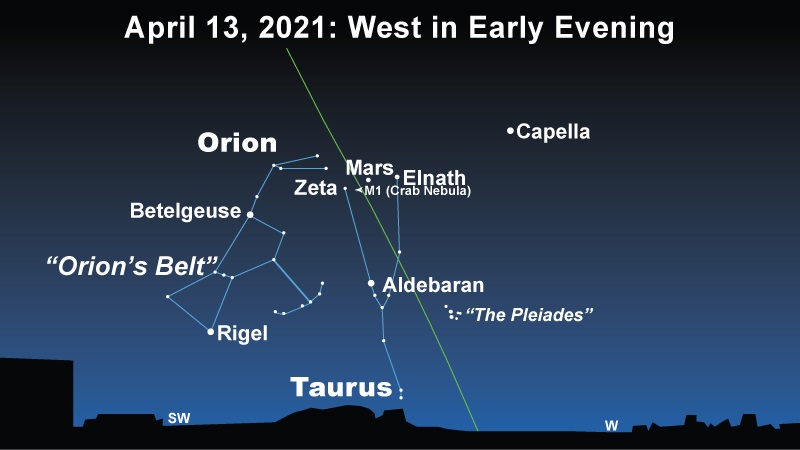
On April 13, 2021, the red planet Mars passes right between the two horn stars in the Constellation Taurus the Bull: Elnath and Zeta Tauri. Yes, these horn stars serve as your guide to the famous supernova remnant, the Crab Nebula. Read more.
Let the moon help guide your eye to the red planet for several nights centered around April 16 or 17. If you live in southeast Asia, you can witness the moon occultating – covering over – Mars on the night of April 17, 2021. Read more.
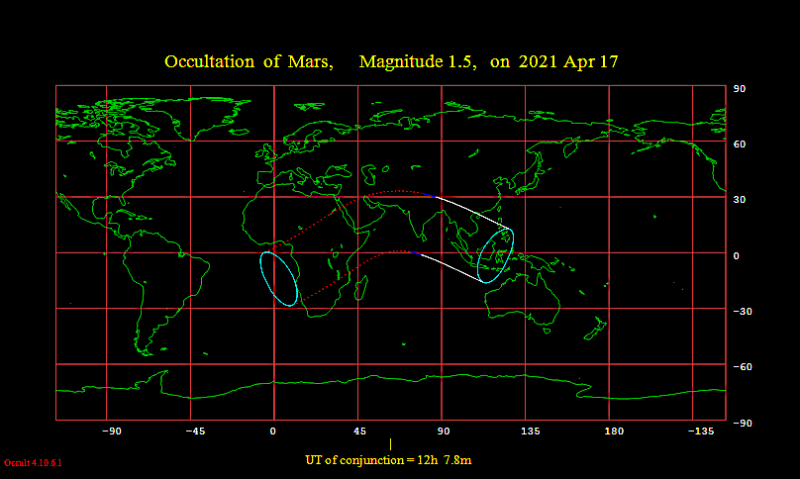
The swath of the Earth’s globe between the solid white lines can watch the lunar occultation of Mars in a nighttime sky. Worldwide map of the lunar occultation of Mars via IOTA (international Occultation Timing Association). Read more.
Read more: What to expect from Mars in 2021
Venus – the brightest planet – reached its greatest elongation of 46 degrees from the sun in the morning sky last year on August 12 or 13, 2020 (depending upon your time zone).
On March 26, 2021, Venus swept to the far side of the sun, to exit the morning sky and to enter the evening sky. That’s when this inferior planet reached superior conjunction. (See diagram below.)
Venus will be hard to spot in April, because it’ll remain close to the sunset glare all month long, and will follow the sun beneath the horizon before dark. By late April – or more likely – May, Venus will return to our skies as an evening “star” near the western horizon. It’ll then be up in the evening, glorious, for the rest of this year.
For the utmost sky watching challenge, try catching the pairing of Mercury and Venus after sunset in the last week in April. Don’t forget binoculars!
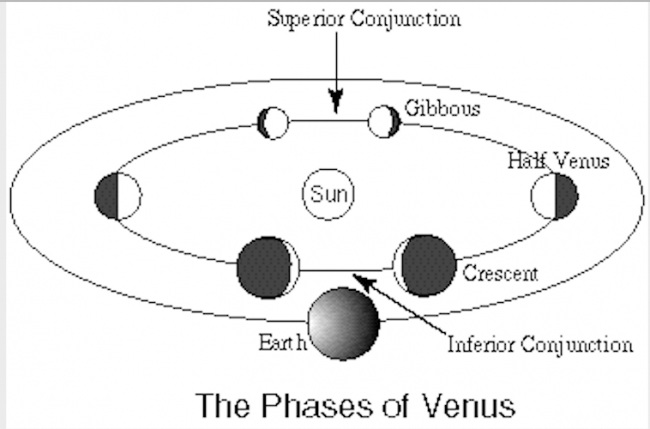
Note: We’re looking at the north side of the solar system, whereby Venus and all the planets travel counterclockwise around the sun. Inferior conjunction – when Venus sweeps between the sun and Earth – happened on June 3, 2020. Some 10 weeks later, Venus reached its greatest elongation in the morning sky on August 13, 2020. Its disk was about 50% illuminated by sunshine. On March 26, 2021, Venus swung to superior conjunction, to to enter the evening sky. Venus will reach its greatest eastern (evening) elongation (Half Venus) on October 29, 2021. Image via UCLA.
Jupiter and Saturn remain somewhat close together, yet are slowly spreading apart, in the April predawn/dawn sky. Both planets are up before dawn’s first light, and will be much easier to view than they were last month.
Saturn rises first. At mid-northern latitudes, Saturn rises about 2 1/2 hours before the sun in early April, and about 3 1/2 hours before the sun at the month’s end. Jupiter follows Saturn into the sky about 1/2 hour later.
At temperate latitudes in the Southern Hemisphere, Saturn rises about 1 1/2 hours after midnight in early April, and by the month’s end, comes up around midnight. (By midnight, we mean midway between sunset and sunrise.) Jupiter follows Saturn into the sky roughly an hour later.
For more specific information on when Jupiter and Saturn rise into your sky, consult either The Old Farmer’s Almanac (U.S. and Canada) or TimeandDate (worldwide).
Use the moon to help guide you to the morning planets on April 5-8, 2021.
Mercury is not easy to see this month, as it transitions from the morning to evening sky. Mercury swings to superior conjunction (see diagram below) on April 19, 2021, to enter the evening sky. After that, Mercury will climb away from the sunset, to reach its greatest eastern (evening) elongation from the setting sun on May 17, 2021. From northerly latitudes, Mercury might first become visible after sunset by late April.
For the Northern Hemisphere, May 2021 will present the best month of the year to view Mercury in the evening sky.
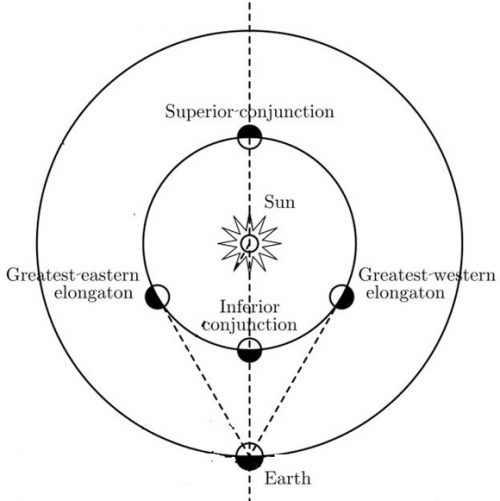
Not to scale. Mercury’s mean distance from the sun is about 0.39 times Earth’s distance from the sun. We’re looking down from the north side of the solar system plane, in which case Mercury and Earth circle the sun in a counterclockwise direction. Earth and Mercury also rotate counterclockwise as seen from the north side of the solar system. At its greatest eastern elongation, Mercury is seen in the west after sunset; and at its greatest western elongation, Mercury is seen in the east before sunrise.
What do we mean by bright planet? By bright planet, we mean any solar system planet that is easily visible without an optical aid and that has been watched by our ancestors since time immemorial. In their outward order from the sun, the five bright planets are Mercury, Venus, Mars, Jupiter and Saturn. These planets actually do appear bright in our sky. They are typically as bright as – or brighter than – the brightest stars. Plus, these relatively nearby worlds tend to shine with a steadier light than the distant, twinkling stars. You can spot them, and come to know them as faithful friends, if you try.
Bottom line: April 2021 presents three bright planets! Mars is the only bright planet to light up the evening sky. Jupiter and Saturn appear in the morning sky. Venus is hard to see because she sits low at dusk, and follows the sun beneath the horizon before darkness falls. Mercury is difficult to view as well, because the solar system’s innermost planet transitions from the morning to evening sky in April 2021.
Don’t miss anything. Subscribe to EarthSky News by email
Visit EarthSky’s Best Places to Stargaze to find a dark-sky location near you.
Help EarthSky keep going! Donate now.
Post your planet photos at EarthSky Community Photos.
from EarthSky https://ift.tt/1YD00CF

Click the name of a planet to learn more about its visibility in April 2021: Jupiter, Saturn, Mars, Venus, Mercury
Try Stellarium for a precise view of the planets from your location.
Want precise planet rise and set times? Click here for recommended almanacs

If you haven’t seen Jupiter and Saturn in the morning sky yet, try using the moon to hop over these worlds in the predawn/dawn hours on April 5, 6, 7 and 8, 2021. Read more.

The young moon sweeps to the north of Aldebaran on or near April 15, and then meets up with Mars for an occultation on the night of April 17 (in southeast Asia). Read more.

The two inferior planets Mercury and Venus will be difficult to view in April 2021. We expect few – if any – to spot their close pairing on the sky’s dome at dusk April 24, 25 and 26, 2021. Read more.
Mars is the only bright planet to light up the evening sky throughout April 2021 (Jupiter and Saturn are found in the predawn/dawn sky all month long, while Venus sits too close to the sunset glare to be easily seen). Best to seek out this modestly-bright world at early evening, when it’s still relatively high in the sky. Mars slowly descends westward during the evening hours, finally setting in the west at or around midnight at mid-northern latitudes, and by mid-evening at temperate latitudes in the Southern Hemisphere.
Mars starts the month in front of the constellation Taurus the Bull and then passes into the constellation Gemini the Twins on April 24, 2021. Enjoy Mars in April 2021! It’s only going to get fainter as this year progresses. In the months ahead, Mars will slowly but surely dim as – day by day – it will sink closer and closer to the setting sun.

On April 13, 2021, the red planet Mars passes right between the two horn stars in the Constellation Taurus the Bull: Elnath and Zeta Tauri. Yes, these horn stars serve as your guide to the famous supernova remnant, the Crab Nebula. Read more.
Let the moon help guide your eye to the red planet for several nights centered around April 16 or 17. If you live in southeast Asia, you can witness the moon occultating – covering over – Mars on the night of April 17, 2021. Read more.

The swath of the Earth’s globe between the solid white lines can watch the lunar occultation of Mars in a nighttime sky. Worldwide map of the lunar occultation of Mars via IOTA (international Occultation Timing Association). Read more.
Read more: What to expect from Mars in 2021
Venus – the brightest planet – reached its greatest elongation of 46 degrees from the sun in the morning sky last year on August 12 or 13, 2020 (depending upon your time zone).
On March 26, 2021, Venus swept to the far side of the sun, to exit the morning sky and to enter the evening sky. That’s when this inferior planet reached superior conjunction. (See diagram below.)
Venus will be hard to spot in April, because it’ll remain close to the sunset glare all month long, and will follow the sun beneath the horizon before dark. By late April – or more likely – May, Venus will return to our skies as an evening “star” near the western horizon. It’ll then be up in the evening, glorious, for the rest of this year.
For the utmost sky watching challenge, try catching the pairing of Mercury and Venus after sunset in the last week in April. Don’t forget binoculars!

Note: We’re looking at the north side of the solar system, whereby Venus and all the planets travel counterclockwise around the sun. Inferior conjunction – when Venus sweeps between the sun and Earth – happened on June 3, 2020. Some 10 weeks later, Venus reached its greatest elongation in the morning sky on August 13, 2020. Its disk was about 50% illuminated by sunshine. On March 26, 2021, Venus swung to superior conjunction, to to enter the evening sky. Venus will reach its greatest eastern (evening) elongation (Half Venus) on October 29, 2021. Image via UCLA.
Jupiter and Saturn remain somewhat close together, yet are slowly spreading apart, in the April predawn/dawn sky. Both planets are up before dawn’s first light, and will be much easier to view than they were last month.
Saturn rises first. At mid-northern latitudes, Saturn rises about 2 1/2 hours before the sun in early April, and about 3 1/2 hours before the sun at the month’s end. Jupiter follows Saturn into the sky about 1/2 hour later.
At temperate latitudes in the Southern Hemisphere, Saturn rises about 1 1/2 hours after midnight in early April, and by the month’s end, comes up around midnight. (By midnight, we mean midway between sunset and sunrise.) Jupiter follows Saturn into the sky roughly an hour later.
For more specific information on when Jupiter and Saturn rise into your sky, consult either The Old Farmer’s Almanac (U.S. and Canada) or TimeandDate (worldwide).
Use the moon to help guide you to the morning planets on April 5-8, 2021.
Mercury is not easy to see this month, as it transitions from the morning to evening sky. Mercury swings to superior conjunction (see diagram below) on April 19, 2021, to enter the evening sky. After that, Mercury will climb away from the sunset, to reach its greatest eastern (evening) elongation from the setting sun on May 17, 2021. From northerly latitudes, Mercury might first become visible after sunset by late April.
For the Northern Hemisphere, May 2021 will present the best month of the year to view Mercury in the evening sky.

Not to scale. Mercury’s mean distance from the sun is about 0.39 times Earth’s distance from the sun. We’re looking down from the north side of the solar system plane, in which case Mercury and Earth circle the sun in a counterclockwise direction. Earth and Mercury also rotate counterclockwise as seen from the north side of the solar system. At its greatest eastern elongation, Mercury is seen in the west after sunset; and at its greatest western elongation, Mercury is seen in the east before sunrise.
What do we mean by bright planet? By bright planet, we mean any solar system planet that is easily visible without an optical aid and that has been watched by our ancestors since time immemorial. In their outward order from the sun, the five bright planets are Mercury, Venus, Mars, Jupiter and Saturn. These planets actually do appear bright in our sky. They are typically as bright as – or brighter than – the brightest stars. Plus, these relatively nearby worlds tend to shine with a steadier light than the distant, twinkling stars. You can spot them, and come to know them as faithful friends, if you try.
Bottom line: April 2021 presents three bright planets! Mars is the only bright planet to light up the evening sky. Jupiter and Saturn appear in the morning sky. Venus is hard to see because she sits low at dusk, and follows the sun beneath the horizon before darkness falls. Mercury is difficult to view as well, because the solar system’s innermost planet transitions from the morning to evening sky in April 2021.
Don’t miss anything. Subscribe to EarthSky News by email
Visit EarthSky’s Best Places to Stargaze to find a dark-sky location near you.
Help EarthSky keep going! Donate now.
Post your planet photos at EarthSky Community Photos.
from EarthSky https://ift.tt/1YD00CF


Aucun commentaire:
Enregistrer un commentaire